 |
The stein seen directly below is an etched, ivory stoneware piece that is marked
HR #407. It was manufactured for Hauber & Reuther by Merkelbach & Wick.
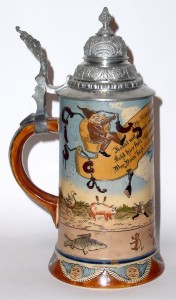 |
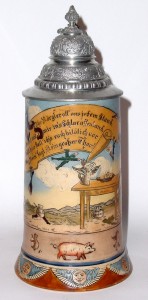 |
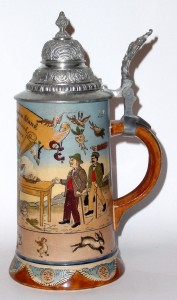 |
Below we see a panorama of the scene on this stein. Note the
abundance of food and drink in this scene, the stein full of beer ready to fly
into the man's hand, the duck flying over the man's head and the pig walking
toward the table, both with eating implements already in place! Referring to
"The Glutton's Paradise" by Hans Sachs:
The Hogs you meet on every side
Are sleek and fat and crisply fried:
They carry knives - it's very nice -
And stand by while you carve your slice!
|
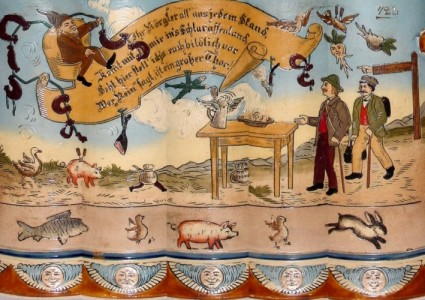 |
The next stein (below) is salt glazed stoneware, or steinzeug, done in
relief, with transfer and enamel d�cor. Actually, we're going to look at two
examples of the same stein. |
The stein shown above features a painted scene on a body which is decorated in
relief above and below the scene. A second version of this stein is shown below,
this time with a large owl dominating the lid. Both of these steins (above and
below) are marked LB&C, have no model number and they were manufactured by
Hauber & Reuther, as evidenced by the miniscule "gesetzlich
gesch�tzt" on the base and the HR capacity mark. Both steins employ a
lizard, or salamander, as the handle, and the stein below features a large (and
original) figural inlay of an owl.
To the best of my knowledge Hauber & Reuther was the only manufacturer to
produce, or have produced for them, steins with the Schlaraffenland theme. The
bases of all three of these steins are similar, but of course, the first is
etched and the others are in relief. |
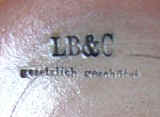
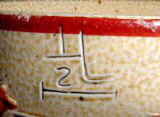 |
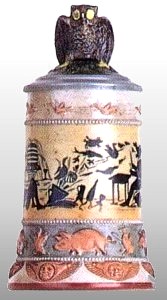 |
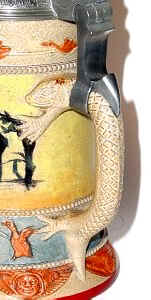 |
Neither the salamander nor the owl have anything to do with the poem, so their
presence on the stein, was somewhat of a mystery until I learned about the Schlaraffia
Society.
|
|
 |
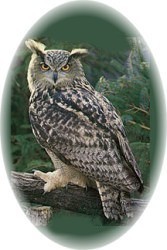 After a bit of
research into the meaning of the steins discussed earlier, the mysteries began
to fade, revealing a couple of interesting stories. The owl, or UHU, has been
recognized since ancient times as a symbol of wisdom, but it is virtually
unknown as the emblem of the Schlaraffia Society. The owl in this case, is the
European Eagle Owl (Bubo bubo), seen at right. After a bit of
research into the meaning of the steins discussed earlier, the mysteries began
to fade, revealing a couple of interesting stories. The owl, or UHU, has been
recognized since ancient times as a symbol of wisdom, but it is virtually
unknown as the emblem of the Schlaraffia Society. The owl in this case, is the
European Eagle Owl (Bubo bubo), seen at right.
The Schlaraffia Society was founded in Prague, on October 10, 1859, by opera
singer Albert Eilers after he was snubbed for membership in Arcadia, an upper
crust association of art aficionados. The goals of Schlaraffia are to foster an
interest in music and the arts, provide some humor and promote friendship among
its members. Songs, poems, or skits, written by members, making fun of the
politically and socially pretentious, may often provide the humor. The selection
of the eagle owl as their emblem was somewhat serendipitous. The Gasthaus, or
hotel, where they held their first meeting had a stuffed eagle owl mounted over
the inside entrance and those in attendance decided that it represented their
interests and goals better than anything else. |
At one time there were 144 Schlaraffia chapters in Germany alone. In 1935 Hitler
ordered the society to expel all of its Jewish members. The society pretended to
comply by removing those member's names from their membership lists. However,
even though their names had been removed from the lists, all were encouraged to
keep attending the meetings. Finally, in 1937 Hitler closed down the chapters
for not complying with his orders, trashed their meeting halls, stripped the
books from their library shelves and burned them.
After World War II it was still necessary for those members in Eastern Europe to
meet secretly because the Society was banned by the Communists. Today they can
once again meet openly in Prague where the society was founded. Shown below are
a couple of modern Schlaraffia pins. The pin to the left is from Schlaraffia
Vindobona. Vindobona is the ancient Roman name for what is now
Vienna, Austria where this Reych, or chapter, is located.
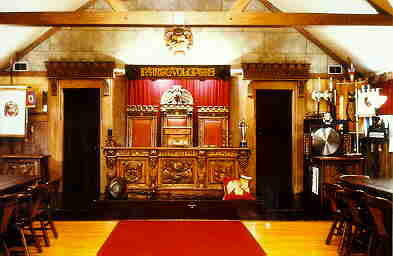
Currently, the Schlaraffia Society has over 400 chapters worldwide, with some
12,500 members, about 1,000 of which reside in the United States. New Jersey
alone has three chapters. The society has only two membership requirements, you
must be male and you must speak German, or at least be willing to learn German.
Their weekly meetings are held in halls called Burgs (see above), where they
dress in medieval costumes, address each other with humorous titles and German
is the only language allowed. Religion, business and politics of a personal
nature, are forbidden subjects within the Burg. All members are considered
equals regardless of their occupation, or station in life. |

The LB&C stein discussed earlier could very well have been produced for sale
to society members. The scene on the body of that steins shows two individuals
dressed in medieval clothing with their street attire hanging on the bushes
behind them; a glove, a top hat, a pair of long trousers and what appears to be
a tie or cravat on one and a student jacket and a pipe on the other. This would
seem to indicate that the characters are in costume only and not actually living
in the middle ages.
Here again this scene reminds us of the promises of Hans Sachs' poem. The fellow
at left need only lie on the ground and wine will gush forth directly into his
mouth, while at right we see an example of -
Roast Chickens, Geese and Pigeons go
Flying within reach, and slow:
And when the birds are winging South
Just gape - they'll fly into your mouth!
|
|
|
|

Let's now try to make some sense out of the use of a salamander as the
handle of the LB&C stein discussed above. The first time I encountered the
word salamander, as it related to beer, or beer steins, was in an article in the
June 1986 Prosit. Jack Lowenstein had reprinted a section from the book
"100 years of Brewing", The Western Brewer, H. S. Rich & Co.,
Chicago/New York 1903 (pp. 689-690); titled "Beer Drinking Customs at the
University of Heidelberg, Baden." An excerpt follows:
|
"The wretch who has lost his beer honor is indeed a pitiful case. Being
declared under the ban by the president, he is forthwith "chalked
down" (by a beer-honorable fox, as already described) with the opprobrious
title, Bierschisser, on the blackboard, the pillory of weak-kneed
drinkers. From this ignominious position he can only extricate himself by
"fighting out" after the manner to be hereafter explained. Meanwhile
he can take no part in the musical diversions of the evening; he must not
participate in the mysterious rite known as "rubbing a salamander"; he
cannot act as beer judge, umpire, or witness in a beer trial; he can not
challenge anyone to drink, or "drink in response" to anyone who may
challenge him; and generally he is in a very bad way." |
 |
In the following, the terms used are a mix of German and
Latin. The translations are how we might expect to hear them in modern English.
The word "salamander," in this case, is derived from the term "Sauft
alle mit einander" (All drink together). However, the word Sauft means
more than just drink; it is one of those over the top words meaning "get
sloshed" or "guzzle." To have a Rubbing of the Salamander ("einem
einen Salamander reiben") proposed to you is evidently considered a
great honor. As the leader, or toast giver, proposes to honor a guest or special
person, all stand and lift their steins at the words of the leader, "Ad
exercitium salamandris praeparatiestisne?" (Are you prepared to do the
salamander?) The drinkers say in unison, "Sumus" (we are). The
leader further orders, "Salamandes inciptur, eins, zwei, drei,"
(Begin the salamander, one, two, three) and each drinker rubs his stein on the
table three times. The leader further instructs them with, "Bibte eins,
zwei, drei" (Drink up, one, two, three) and all steins are emptied in
unison to the count one, two, three. They are then rattled on the table till the
leader once again says, "Eins, zwei..." (one, two...) and all
steins are held still until the leader says,"Drei!" (three)
whereupon all bang their steins on the table.
A variation of this is the "Trauersalamander."
All done as before, except the glasses are "rubbed" in the air and
they are stopped before striking the table. A silent, solemn ceremony honoring a
departed brother.
I believe the student blazer and pipe on the bush behind the
individual at the left of the scene on the LB&C stein is the connection to
the handle that identifies it as a salamander. Even if you don't agree with this
assumption, you will at least know how to "rub a salamander" in case
you are ever called upon to do so.
|

PARAGRAPH 11
The lid seen below is the one David Harr installed on the LB&C stein
discussed above, which also has a "Paragraph 11" thumblift (seen below
right). To refresh everyone's memory as to the meaning of Paragraph 11 is the
following quote, again from "100 Years of Brewing":
"The beer code, or Bier-Comment of the Senior University,
Heidelberg, as it is officially known, has passed through several revisions and
editions since 1829. In common with other university beer codes, however, the
Heidelberg laws begin with paragraph 11. Paragraphs 1 to 10 are left blank,
being presumably the ten commandments of the Old Testament. The eleventh
paragraph, or commandment of Heidelberg University reads: Es wird
fortgesoffen, or, freely translated, "Keep on drinking."
Die Schweningerkur
On the lid, which I feel is at least as appropriate, if not more so than the
original, we see a robust gentleman with his bowl of dumplings, and on the table
in front of him, more dumplings, a roast chicken, a loaf of bread, his 1.0 liter
beer stein and a jug, on the floor beside him, for refills. All in all, a great
lid and thumblift for a stein representing the Glutton's Paradise. However, over
the man's head is a sign, seen below, that reads "Schweningerkur"
and this was also a mystery.

I inquired on the SCI web site to see if anyone was familiar
with the word and I received one reply that, while it was a good guess,
unfortunately turned out to be incorrect. That same day, I received an e-mail
from Walt Vogdes to let me know that he had tried the Internet, and got a couple
of hits on the word, but hadn't attempted to determine the word's meaning. So, I
tried the Internet myself and got three hits. The first hit was for a book
appropriately titled "Die Schweningerkur" and the other two
were extracts from German publications that contained the word. The book had
been written by one Oskar Mass and published in Berlin by Steinitz & Fischer
in 1886. The second hit concerned a group of friends, one of whom was a former
drunk and was now on the wagon after taking the Schweningerkur. The third
was about a person who was traveling in the Middle East, was over weight, and
wished they had had time to take the Schweningerkur before making the
trip. Evidently the cure addressed both eating and drinking disorders. Was the Schweningerkur
one of those fad cures that were very popular during the latter part of the 19th
century, not unlike today's many fad diets? Possibly it was, because about six
weeks after my inquiry, I received a second reply. Apparently the Schweningerkur
was devised by one Dr. Ernst Schweninger (1850-1924) who in 1882, became the
personal physician of Otto von Bismarck. Bismarck had both eating and drinking
problems and Dr. Schweninger devised a plan of exercise and proper diet for him
that helped him loose weight and keep it off. Bismarck declared that
"Without him I would have died." After that, Dr. Schweninger became a
"Celebrity Doctor" and in addition to Bismarck he became the personal
physician to Alfred Krupp and Cosima Wagner. The "Schweningerkur"
sign on this lid, may have been a reminder to the owner not to over indulge, or
they might have to take the Schweningerkur.
|
Portions of this article first appeared in Prosit, but before the article
appeared in print it began to grow. This version is considerably expanded, and
covers additional material and newly acquired steins. Walt Vogdes was
instrumental in structuring my work for the SCI web site.
My thanks also to Walt Vogdes and Terry Hill for the information on
"Rubbing a Salamander" and to Marc Lang and Walt Vogdes for help in
decyphering the inscriptions on the Schlaraffia Society steins.
BIBLIOGRAPHY:
Lowenstein, Jack, Beer Drinking Customs at the University of
Heidelberg, Baden, an excerpt from One Hundred Years of Brewing, the Western
Brewer, H. S. Rich & Co., Chicago/New York, 1903 (pp. 689-690).
Oxford English Dictionary, vol. 18, Oxford: Clarendon, 1989.
Hinrichs, Hans, The Glutton's Paradise, Being a Pleasant
Dissertation on Hans Sachs' Schlaraffenland and Some Similar Utopias, Peter
Pauper Press, Mount Vernon/New York, 1955.
ON-LINE REFERENCES:
Hans Sachs:
www.hymnsandcarolsofchristmas.com/Hymns_and_Carols/Biographies/hans_sachs.htm
Schlaraffia Society:
www.gacl.org/schlar.html
members.aol.com/germanclub/engnyt.html
Schweningerkur:
www.slaek.de/aebl_fs.htm?/aebl/2003/11/pdf/1103_495.pdf
� Stein Collectors
International 1996-2014
All rights reserved.
|
|



